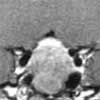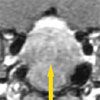- Clinical Technology
- Adult Immunization
- Hepatology
- Pediatric Immunization
- Screening
- Psychiatry
- Allergy
- Women's Health
- Cardiology
- Pediatrics
- Dermatology
- Endocrinology
- Pain Management
- Gastroenterology
- Infectious Disease
- Obesity Medicine
- Rheumatology
- Nephrology
- Neurology
- Pulmonology
Galactorrhea and Headaches in a Nonpregnant Woman
A 28-year-old woman presents with milky discharge in both breasts and throbbing occipital headaches of 4 months' duration. The headaches begin gradually, do not radiate, and have no apparent triggers or relieving factors.
A 28-year-old woman presents with milky discharge in both breasts and throbbing occipital headaches of 4 months' duration. The headaches begin gradually, do not radiate, and have no apparent triggers or relieving factors; the severity of the pain ranges from 5 to 10 on a 10-point scale. The headaches are accompanied by intermittent nausea but not by vomiting, photophobia, or visual disturbances. In addition, the patient is easily fatigued with minimal activity and has gained 30 lb in the past 3 months.
She denies fever, rigors, night sweats, cough, chest pain, dyspnea, seizures, syncope, weakness, paresthesias, ataxia, tremors, vision changes, urinary symptoms, bleeding diathesis, and vaginal discharge. She also denies any blood-stained discharge from her nipples, erythema or lumps in her breasts, and excessive manipulation of the breasts.
She has had 2 normal pregnancies but has been amenorrheic for the past 2 1/2 months; before that, her periods were somewhat irregular. Her last pregnancy was 6 years earlier. An ovarian cyst was removed 4 years ago. She does not smoke, drink alcohol, or use illicit drugs. Her only medication is acetaminophen, which she uses occasionally. She is sexually active and monogamous. Her mother had migraine.
Heart rate is 84 beats per minute and regular; respiration rate, 18 breaths per minute; and blood pressure in the right arm, 112/70 mm Hg. Patient is afebrile. Weight is 211 lb; height, 5 ft 3 in. She is well hydrated. There is no evidence of anemia, clubbing, cyanosis, hirsutism, adenopathy, icterus or facial erythema; throat and ears are normal. Skin is of normal texture, moist, and elastic, without pallor or hyperpigmentation. The thyroid gland is of normal size. Breasts are devoid of masses, but milky discharge is evident. Results of a pelvic examination are normal. No ankle swelling is noted. A neurological examination reveals a normal skull and spine, no sinus tenderness, palpable and equal carotid arteries, intact cranial nerves, no visual defects or papilledema, deep tendon reflexes and plantar and flexor reflexes that are equal bilaterally, no Romberg sign, no meningeal or cerebellar signs, and a normal gait. She is awake, alert, and oriented, and results of motor and sensory examinations are normal.
Hemoglobin level is 13.2 g/dL; white blood cell count, 5200/µL with normal differential; platelet count, 180,000/µL; erythrocyte sedimentation rate, 12 mm/h; serum glucose, 100 mg/dL; blood urea nitrogen level, 18 mg/dL; creatinine level, 1 mg/dL; sodium level, 137 mEq/L; potassium level, 4.0 mEq/L; chloride level, 100 mEq/L; carbon dioxide level, 24 mEq/L; serum cholesterol level, 204 mg/dL; triglyceride level, 220 mg/dL; high-density lipoprotein cholesterol level, 46 mg/dL; low-density lipoprotein cholesterol level, 102 mg/dL; and prolactin level, 83 µg/mL (normal, 2.8 to 29.2). Results of urinalysis are normal, and results of a pregnancy test are negative.
Follicle-stimulating hormone level is 1.7 IU/L; luteinizing hormone (LH) level, 3.3 IU/L; 17-b estradiol level, less than 10 pg/mL; thyroid-stimulating hormone (TSH) level, 1.45 µIU/mL; growth hormone level, 2.09 ng/mL; and free urinary cortisol, 13 µg/24 h. Visual field mapping reveals no defects.

An MRI scan of the brain is shown here.
Based on the clinical findings, laboratory results, and MRI scan, what is the most likely diagnosis?A. Macroadenoma of the pituitary.
B. Meningioma.
C. Brain abscess.
D. CNS lymphoma.

WHAT'S WRONG:
Galactorrhea, headaches, a large mass in the sella turcica, an elevated prolactin level, and a low LH level in a young woman in whom all other results of an endocrine workup are normal strongly suggest a macroadenoma of the pituitary gland (A).
Meningioma (choice B) may be asymptomatic or the patient may present with headache and seizures. However, galactorrhea is not seen with meningioma. Also, CT or MRI shows a peripheral tumor involving the meninges.
Patients in whom brain abscess (choice C) develops usually have a predisposing risk factor, such as complicated sinusitis, complicated otitis, head injury, endocarditis, or HIV infection. This woman had no such risk factor. The presenting symptoms in brain abscess include fever with mass effect (eg, seizures), which were not seen here. CT scan may show one or more ring-enhancing lesions.
CNS lymphoma (choice D) is usually associated with immunosuppression (eg, HIV infection), and affected patients complain of constitutional symptoms with fever and mass effects, including seizures. CT or MRI scan usually shows a single ring-enhanced lesion in the brain parenchyma.
Management. The patient was referred to a neurosurgeon and an endocrinologist. Treatment with bromocriptine was begun, with regular follow-up recommended.
PITUITARY ADENOMAS: AN OVERVIEW
Pituitary adenomas account for about 10% to 15% of intracranial tumors.1 These lesions are classified as either microadenomas (less than 10 mm) or macroadenomas (greater than 10 mm). Adenomas can also be classified based on the hormones they produce. Prolactin-secreting tumors (prolactinomas) are the most common, accounting for up to 45% of all adenomas.2 Growth hormone–secreting tumors, which clinically cause acromegaly and gigantism, account for 15% of adenomas.1 Tumors that secrete adrenocorticotropic hormone or TSH are less common. Up to a third of pituitary adenomas are biologically inactive and are detected in asymptomatic patients undergoing imaging studies for other reasons. These are commonly referred to as incidentalomas.
CLINICAL PRESENTATION OF PROLACTINOMAS
Prolactinomas present differently depending on the sex of the patient. Women present with oligomenorrhea, amenorrhea, or infertility. Galactorrhea occurs in up to 80% of women with prolactinomas.3 Vaginal dryness, dyspareunia, and osteopenia/osteoporosis may result from hypoestrogenism. Affected men have diminished libido, erectile dysfunction, and decreased energy; galactorrhea occurs less commonly. Larger tumors may produce nonspecific headaches or visual field defects, such as bitemporal hemianopsia, which result from compression of the optic chiasm.
NAILING DOWN THE DIAGNOSIS
Obtain a complete history to exclude other causes of hyperprolactinemia, such as pregnancy, lactation, and nipple stimulation. Certain medications, including risperidone, phenothiazines, haloperidol, metoclopramide, cimetidine, methyldopa, and verapamil, are also frequently implicated.
Physical findings are often normal. Galactorrhea presents as a clear to milky nipple discharge, especially in women. Testicular atrophy may be noted in men. Prolactin levels often correlate with the size of the tumor. A random prolactin level of more than 100 ng/mL is consistent with a prolactinoma; macroadenomas often produce levels of more than 200 ng/mL. Perform a urine pregnancy test and a renal function test and measure the TSH level to exclude other causes of elevated prolactin levels. A brain MRI scan is the imaging study of choice to confirm the diagnosis.
Although this patient's prolactin level is less than 100 ng/mL, it is still significantly above normal. Together with negative results on the rest of her endocrine workup, it is sufficient to diagnose prolactinoma.
TREATMENT OF PROLACTINOMAS
Treatment is indicated in patients with symptoms of hypogonadism and/or neurological impairment. Medical therapy is the treatment of choice for most prolactinomas; surgery is rarely needed.
The goals of treatment are:
• To lower prolactin levels.
• To decrease tumor size.
• To reduce galactorrhea.
• To restore menses and fertility.
Regardless of their size, prolactinomas are initially treated with dopamine agonists, such as bromocriptine or cabergoline. Cabergoline may be a better initial choice because it is more potent, is dosed less frequently (once or twice a week, compared with twice daily), and has a better adverse-effect profile than bromocriptine. However, bromocriptine costs less than half what cabergoline costs and is included in many formularies. Common adverse effects of both dopamine agonists include nausea and postural hypotension. Less common adverse effects include nasal stuffiness, constipation, and fatigue.
Once treatment is begun, monitor symptoms, prolactin levels, and medication adverse effects regularly. Adjust the dosage as needed, with the goal of achieving the lowest effective dosage. If prolactin levels remain normal for more than 2 years, the dopamine agonist may be discontinued. Eventual discontinuation (after 2 years) may also be appropriate in patients with macroadenomas less than 2 cm in size at the time of diagnosis.
Transsphenoidal resection is reserved for patients with progressive neurological symptoms and for those who cannot tolerate or who fail to respond to dopamine agonists.
References:
REFERENCES:
1. Gsponer J, De Tribolet N, Déruaz JP, et al. Diagnosis, treatment, and outcome of pituitary tumors and other abnormal intrasellar masses. Retrospective analysis of 353 patients. Medicine (Baltimore). 1999;78:236-269.
2. Ciccarelli A, Daly AF, Beckers A. The epidemiology of prolactinomas. Pituitary. 2005;8:3-6.
3. Schlechte JA. Clinical practice. Prolactinoma. N Engl J Med. 2003;349:2035-2041.
